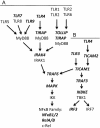Genetic variation in TLR or NFkappaB pathways and the risk of breast cancer: a case-control study
- PMID: 23634849
- PMCID: PMC3651307
- DOI: 10.1186/1471-2407-13-219
Genetic variation in TLR or NFkappaB pathways and the risk of breast cancer: a case-control study
Abstract
Background: Toll-like receptors (TLRs) and the transcription factor nuclear factor-κB (NFκB) are important in inflammation and cancer.
Methods: We examined the association between breast cancer risk and 233 tagging single nucleotide polymorphisms within 31 candidate genes involved in TLR or NFκB pathways. This population-based study in the Seattle area included 845 invasive breast cancer cases, diagnosed between 1997 and 1999, and 807 controls aged 65-79.
Results: Variant alleles in four genes were associated with breast cancer risk based on gene-level tests: MAP3K1, MMP9, TANK, and TLR9. These results were similar when the risk of breast cancer was examined within ductal and luminal subtypes. Subsequent exploratory pathway analyses using the GRASS algorithm found no associations for genes in TLR or NFκB pathways. Using publicly available CGEMS GWAS data to validate significant findings (N = 1,145 cases, N = 1,142 controls), rs889312 near MAP3K1 was confirmed to be associated with breast cancer risk (P = 0.04, OR 1.15, 95% CI 1.01-1.30). Further, two SNPs in TANK that were significant in our data, rs17705608 (P = 0.05) and rs7309 (P = 0.04), had similar risk estimates in the CGEMS data (rs17705608 OR 0.83, 95% CI 0.72-0.96; CGEMS OR 0.90, 95% CI 0.80-1.01 and rs7309 OR 0.83, 95% CI 0.73-0.95; CGEMS OR 0.91, 95% CI 0.81-1.02).
Conclusions: Our findings suggest plausible associations between breast cancer risk and genes in TLR or NFκB pathways. Given the few suggestive associations in our data and the compelling biologic rationale for an association between genetic variation in these pathways and breast cancer risk, further studies are warranted that examine these effects.
Figures

Similar articles
-
Association between mitogen-activated protein kinase kinase kinase 1 polymorphisms and breast cancer susceptibility: a meta-analysis of 20 case-control studies.PLoS One. 2014 Mar 4;9(3):e90771. doi: 10.1371/journal.pone.0090771. eCollection 2014. PLoS One. 2014. PMID: 24595411 Free PMC article.
-
Association between mitogen-activated protein kinase kinase kinase 1 rs889312 polymorphism and breast cancer risk: evidence from 59,977 subjects.Breast Cancer Res Treat. 2011 Apr;126(3):663-70. doi: 10.1007/s10549-010-1151-1. Epub 2010 Sep 1. Breast Cancer Res Treat. 2011. PMID: 20809358
-
Genetic variation in the TLR and NF-κB pathways and cervical and vulvar cancer risk: a population-based case-control study.Int J Cancer. 2014 Jan 15;134(2):437-44. doi: 10.1002/ijc.28364. Epub 2013 Aug 5. Int J Cancer. 2014. PMID: 23824834 Free PMC article.
-
Association of MMP2 and MMP9 gene polymorphisms with the recurrent spontaneous abortion: A meta-analysis.Gene. 2021 Jan 30;767:145173. doi: 10.1016/j.gene.2020.145173. Epub 2020 Sep 29. Gene. 2021. PMID: 33007375 Review.
-
Breast cancer genome-wide association studies: there is strength in numbers.Oncogene. 2012 Apr 26;31(17):2121-8. doi: 10.1038/onc.2011.408. Epub 2011 Sep 26. Oncogene. 2012. PMID: 21996731 Review.
Cited by
-
NF-kB2 Genetic Variations are Significantly Associated with Non-Small Cell Lung Cancer Risk and Overall Survival.Sci Rep. 2018 Mar 27;8(1):5259. doi: 10.1038/s41598-018-23324-3. Sci Rep. 2018. PMID: 29588475 Free PMC article.
-
Integration of multiomics data shows down regulation of mismatch repair and tubulin pathways in triple-negative chemotherapy-resistant breast tumors.Breast Cancer Res. 2023 May 24;25(1):57. doi: 10.1186/s13058-023-01656-x. Breast Cancer Res. 2023. PMID: 37226243 Free PMC article.
-
Significant Association of Matrix Metalloproteinase-9 Polymorphisms With Triple Negative Breast Cancer Risk.Cancer Genomics Proteomics. 2025 Mar-Apr;22(2):258-270. doi: 10.21873/cgp.20500. Cancer Genomics Proteomics. 2025. PMID: 39993804 Free PMC article.
-
Innate Immune Program in Formation of Tumor-Initiating Cells from Cells-of-Origin of Breast, Prostate, and Ovarian Cancers.Cancers (Basel). 2023 Jan 26;15(3):757. doi: 10.3390/cancers15030757. Cancers (Basel). 2023. PMID: 36765715 Free PMC article. Review.
-
Association between mitogen-activated protein kinase kinase kinase 1 polymorphisms and breast cancer susceptibility: a meta-analysis of 20 case-control studies.PLoS One. 2014 Mar 4;9(3):e90771. doi: 10.1371/journal.pone.0090771. eCollection 2014. PLoS One. 2014. PMID: 24595411 Free PMC article.
References
Publication types
MeSH terms
Substances
Grants and funding
LinkOut - more resources
Full Text Sources
Other Literature Sources
Medical
Miscellaneous

